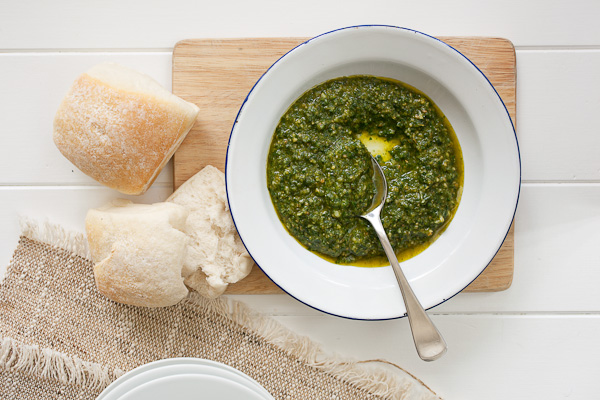
Autumn is the perfect time to dig out your pesto recipe and get making pesto. Whether it is traditional basil pesto, red capsicum pesto, rocket or coriander pesto, it is time to get grinding.
Most years I have enough basil to supply restaurants but this year it was miserable. I would like to blame it on the weather, however my neighbour Bridget, has enough basil to give away, therefore I must accept that it is my gardening and little else!
Thankfully Bridget is generous and rather than missing my pesto making morning, she is sharing her crop with me, ensuring that I have plenty of frozen cubes for soups etc… in the months ahead.
Pesto Genovese is from Genoa, Liguria, Italy and is a sauce made from garlic, pine nuts, basil, parmesan cheese and olive oil.
There is an indepth look at the history and characteristics from a previous foodlovers pesto feature by Virgil.
While garlic is popular there are traditional recipes that omit it and it is up to you whether you include it or not.
Most traditional Italian recipes will tell you the importance of using fresh pine nuts which until recently were unheard of in NZ. However with Pinoli pine nuts from Marlborough having an online store there is very little reason not to have fresh nuts!
Commercial manufacturers will often use cashew nuts as a cheaper option and while I have done the same, fresh pine nuts are completely superior in flavour and texture.
Traditionally pesto is made by hand with a mortar and pestle, while food processors make life easy you should still make sure that you process your pesto in short bursts, one to stop it becoming a complete puree and two to prevent the blade heating too much and therefore “cooking” the basil and affecting its fresh flavour.
The word pesto refers to the pounding as opposed to the specifics of the recipe, it is acceptable to call other flavoured pastes pesto such as sundried tomato pesto and rocket pesto.
To make rocket pesto use rocket instead of basil and substitute walnuts for the pine nuts.
Basil oxidises quickly when exposed to air or heat and can turn brown. To keep your pesto bright green either pour a film of oil over the surface or cover with plastic clingfilm allowing the film to actually cling to the pesto itself.
There are varying thoughts about the freezing of pesto and what works and doesn’t Many believe that the garlic flavour is unfavourably altered by freezing and others that you should freeze without the nuts. I alternate in freezing just pulsed basil leaves with olive oil or full pesto. The pesto cubes are usually added to vegetable soup during winter and I am happy with them.
Uses for pesto
- with pasta – of course
- on pizza – with or without the tomato base.
- stirred through risotto
- mixed into mashed potato
- dolloped on top of soups
- with eggs on toast
- mixed into mayonnaise
- As a spread in sandwiches
- with cream cheese on toasts or in sandwiches
- as a dip
- with goats cheese on crostini
- in chicken lasagne
- in chicken stuffing – either breasts or in actual roast chicken
Parsley, Basil, Walnut and Almond Pesto Recipe
Red Capsicum and Cashew Dip (pesto)
Chicken and Pesto Lasagne Recipe
Eggplant, Goats Cheese and Pesto Stack
What sort of pesto do you make and what do you do with it?




Please can you tell me a recipe for an ambient pesto
sauce. I want to make it to keep it in the pantry. Also, how long would it last?
Many thanks in advance.
oops…. click on the recipe for “parsley,basil walnut and almond pesto” and you come up with the recipe for “coriander pesto” . Has anyone else had this problem?
My attempts at pesto have not been that successful. Perfectly okay in texture etc but it has been hard to judge the amount of basil when recipe refers to cups. It all depends on how densely you pack it. Too much and the pesto can be very bitter. How about a measure in grams?
last year I had a surplus of chervil and found it made wonderful pesto .. simply followed one of Annabel langbeins early recipes for making Basil pesto. this inspired me to explore other ‘gluts’ most successful was a corriander pesto,utilising cashews which are considerably cheaper than pinenuts, and when lightly toasted are a great substitute. My attempt at making a pesto with sorrel wasn’t a great outcome .. for my taste that is.